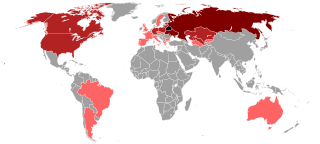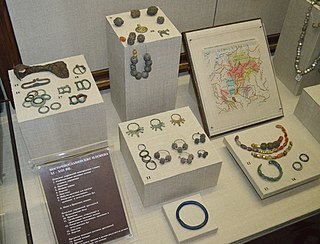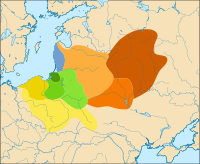
Belarusians are an East Slavic ethnic group native to Belarus. More than 9.5 million people proclaim Belarusian ethnicity worldwide. Nearly 8 million Belarusians reside in Belarus, with the United States and Russia being home to more than half a million Belarusians each.

The East Slavs are the most populous subgroup of the Slavs. They speak the East Slavic languages, and formed the majority of the population of the medieval state Kievan Rus', which they claim as their cultural ancestor. Today, the East Slavs consist of Belarusians, Russians, Rusyns, and Ukrainians.

The Severians, also Severyans, Siverians, or Siverianians were a tribe or tribal confederation of early East Slavs occupying areas to the east of the middle Dnieper River and southeast of the Danube River. They are mentioned by the Bavarian Geographer, Emperor Constantine VII (956–959), the Khazar ruler Joseph, and in the Primary Chronicle (1113).

Polesia, Polissia, Polesie, or Polesye is a natural and historical region in Eastern Europe, including part of Eastern Poland, the Belarus–Ukraine border region.

The Dnieper, also called Dnipro, is one of the major transboundary rivers of Europe, rising in the Valdai Hills near Smolensk, Russia, before flowing through Belarus and Ukraine to the Black Sea. Approximately 2,200 km (1,400 mi) long, with a drainage basin of 504,000 square kilometres (195,000 sq mi), it is the longest river of Ukraine and Belarus and the fourth-longest river in Europe, after the Volga, Danube, and Ural rivers.

The Pripyat or Prypiat is a river in Eastern Europe, approximately 761 km (473 mi) long. It flows east through Ukraine, Belarus, and Ukraine again, draining into the Dnieper.

The Dregoviches or Dregovichi were one of the tribal unions of the early East Slavs. They inhabited the territories along the lower Pripyat River and the northern parts of the right bank of the Dnieper River. The name of the tribe probably derives from the Old Ruthenian word дрегва or дрягва because the Dregoviches used to live in the marshlands.

The Polans or Polians, also known as Polanians, Polianians, and Eastern Polans, were an East Slavic tribe between the 6th and the 9th century, which inhabited both sides of the Dnieper river from Liubech to Rodnia and also down the lower streams of the rivers Ros', Sula, Stuhna, Teteriv, Irpin', Desna and Pripyat.

The Radimichs were an East Slavic tribe of the last several centuries of the 1st millennium, which inhabited upper east parts of the Dnieper down the Sozh and its tributaries. The name probably derives from the name of the forefather of the tribe - Radim. According to Russian chronicle tradition, "... but there were Radimichs from the Lechites family, who came and settled here and paid tribute to Rus, and the wagon was carried to the present day". However, in the scientific literature, there is no consensus on the ethnicity of the Radimichs. Archaeological evidence indicates that this tribal association had a mixed Slavic-Baltic origin.

The Tivertsi, were a tribe of early East Slavs which lived in the lands near the Dniester, and probably the lower Danube, that is in modern-day western Ukraine and Republic of Moldova and possibly in eastern Romania and southern Odesa oblast of Ukraine. The Tivertsi were one of the tribes that formed the Ukrainian ethnicity, namely the sub-ethnic and historic region of Podolia. The Tivertsis' cultural inheritors, the Podolians, are a distinct group of Ukrainians.

The Zarubintsy or Zarubinets culture was a culture that, from the 3rd century BC until the 1st century AD, flourished in the area north of the Black Sea along the upper and middle Dnieper and Pripyat Rivers, stretching west towards the Southern Bug river. Zarubintsy sites were particularly dense between the Rivers Desna and Ros as well as along the Pripyat river. It was identified around 1899 by the Czech-Ukrainian archaeologist Vikentiy Khvoyka and is now attested by about 500 sites. The culture was named after finds of cremated remains in the village of Zarubyntsi on the Dnieper.

The Middle Dnieper culture is a formative early expression of the Corded Ware culture, ca. 3200—2300 BC, of northern Ukraine and Belarus.

The White Croats, also known simply as Croats, were a group of Early Slavic tribes that lived among other West and East Slavic tribes in the historical region of Galicia north of the Carpathian Mountains, in modern western Ukraine, Lesser Poland, Eastern Slovakia, and Northeastern Bohemia.

The Kyiv culture or Kiev culture is an archaeological culture dating from about the 3rd to 5th centuries, named after Kyiv, the capital of Ukraine. It is widely considered to be the first identifiable Slavic archaeological culture. It was located in the "middle and upper Dnieper basin, akin to it sites of the type Zaozer´e in the upper Dnieper and the upper Dvina basins, and finally the groups of sites of the type Cherepyn–Teremtsy in the upper Dniester basin and of the type Ostrov in the Pripyat basin, in Ukraine and Belarus. It was contemporaneous to the Chernyakhov culture.

Goryuns, also Horiuns or Horyuny, a little-documented ethnic group of East Slavs, live around Putyvl, now in the Sumy Oblast of north-eastern Ukraine, in the past in Kursk Governorate of the Russian Empire. The dialect of the Russian language spoken by Goryuns has some features of Belarusian and Ukrainian.

The Antes, or Antae, were an early East Slavic tribal polity of the 6th century CE. They lived on the lower Danube River, in the northwestern Black Sea region, and in the regions around the Don River. Scholars commonly associate the Antes with the archaeological Penkovka culture.

The early Slavs were an Indo-European peoples who lived during the Migration Period and the Early Middle Ages in Central and Eastern Europe and established the foundations for the Slavic nations through the Slavic states of the High Middle Ages. The Slavs' original homeland is still a matter of debate due to a lack of historical records; however, scholars believe that it was in Eastern Europe, with Polesia being the most commonly accepted location.
The Korchak culture is an archaeological culture of the sixth and seventh century East Slavs who settled along the southern tributaries of the Pripyat River and from the Dnieper River to the Southern Bug and Dniester rivers, throughout modern-day northwestern Ukraine and southern Belarus.
The Slavic migrations to the Balkans began in the mid-6th century and first decades of the 7th century in the Early Middle Ages. The rapid demographic spread of the Slavs was followed by a population exchange, mixing and language shift to and from Slavic.

The Stsviha or Stvyha is a river of Ukraine and Belarus. It is a tributary of the Pripyat River in the Dnieper basin. A notable marsh wetland known as the Polesia, home to about 265 different species of bird, lies between the Pripyat, Stsviha and Ubort Rivers.
















